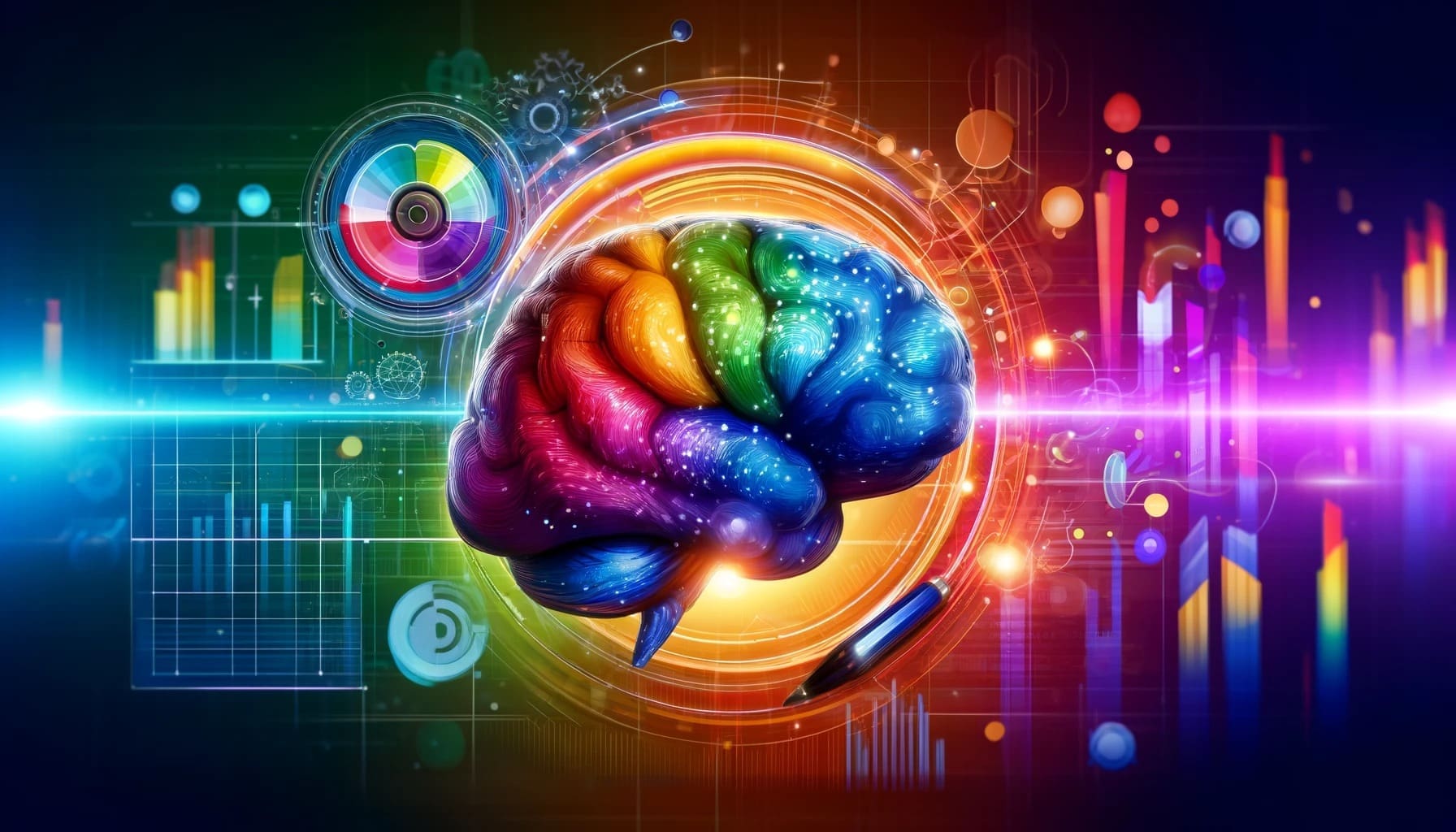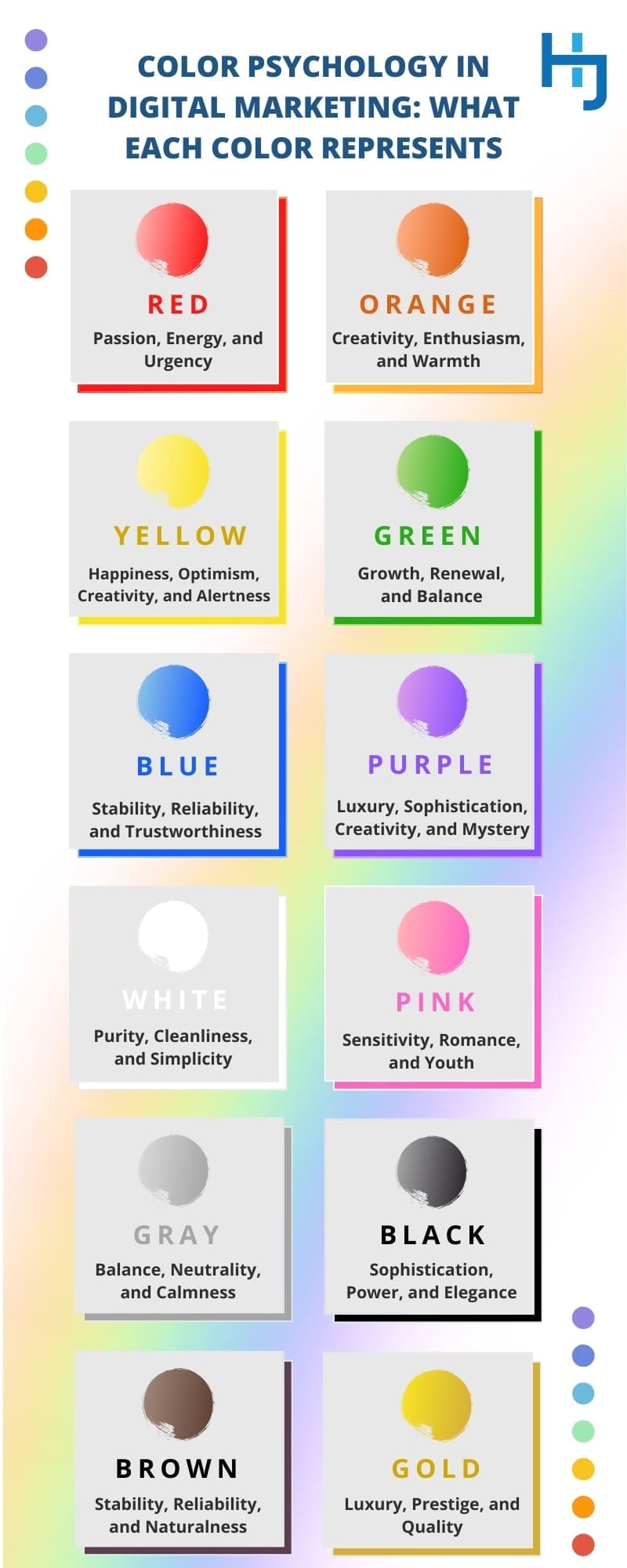 Have you ever wondered why IBM is associated with blue or why UPS covers everything in brown? It’s all about the psychology of color. These hues send subtle cues to people about how the brands want to be perceived – and it works. Give me a few minutes, and I’ll walk you through the basics of color psychology in digital marketing and best practices for leveraging color in your digital marketing strategy.
Have you ever wondered why IBM is associated with blue or why UPS covers everything in brown? It’s all about the psychology of color. These hues send subtle cues to people about how the brands want to be perceived – and it works. Give me a few minutes, and I’ll walk you through the basics of color psychology in digital marketing and best practices for leveraging color in your digital marketing strategy.
The Science of Color Psychology in Marketing
At its core, color psychology is based on the principle that colors can psychologically impact viewers, affecting their mood and purchasing decisions. This is due to how our brains process colors and the associative connections we have with them.
Colors Evoke Emotion
Colors are often associated with feelings or ideas. For instance:
- Warm colors like red, yellow, and orange can create feelings of warmth and comfort but can also stimulate and energize the viewer. These colors often grab attention quickly, making them useful for calls to action or during clearance sales.
- Cool colors such as blue, purple, and green typically create a sense of calm and trust. Banks and healthcare companies frequently use them to promote safety and reliability.
Consistent Use of Colors Increases Brand Recognition

It’s often said that using color strategically can enhance brand recognition by 80 percent. Research backing up this claim is lacking, as print expert Eddy Hagen notes. While studies have shown that the use of color compared to black-and-white print does improve brand recognition, it has not been proven that small color differences make a difference or will influence brand recognition or trust.
Take this image of coffee cups, for example. Two of the colors match the hues leveraged by major coffee chains as part of their branding strategies. Chances are, you can identify at least one of the brands even without seeing the logo. You can also likely tell whether the “A” or “B” version is the shade used by the brand. (You’ll be able to check your answers as we explore the colors in depth in a moment.) This is one of the reasons why choosing the right colors serves your brand well in the long run.
Colors Impact User Experience
Color can also affect usability and readability. For example, high-contrast color pairs, such as black text on a white background, are often used on websites to improve the readability of content. This is essential for maintaining user engagement and reducing bounce rates.
Color Psychology in Digital Marketing: What Each Color Represents
Each color has a unique meaning and cultivates a specific emotion in the viewer’s mind. While the meaning may vary based on cultural backgrounds and other influences, the descriptions below suit most audiences.
Red: Passion, Energy, and Urgency
Red is one of the spectrum’s most dynamic and powerful colors, commonly associated with passion, energy, and urgency. In the context of color psychology, red can evoke strong emotions, ranging from love and warmth to danger and caution. This dual nature makes it a very effective tool in digital marketing when used appropriately.
Psychological Impact of the Color Red
Red is a stimulant. It can literally induce hunger by boosting metabolism and raising blood pressure, per Psychologist World. Additionally, it grabs attention faster than any other color and is often used in marketing to provoke impulsive decisions. It’s no coincidence that red is frequently used in “sale” signs and clearance events. It creates a sense of urgency and can push consumers to act quickly.
Common Applications for Red in Digital Marketing
- Call to Action (CTA): Red is an excellent choice for CTA buttons like “Buy Now” or “Click Here” because it stands out against other elements on the page, drawing attention and encouraging clicks.
- Brand Identity: Brands that want to project an image of boldness and excitement often use red in their logos. Think of Coca-Cola or Red Bull. Both use red to convey a sense of youthfulness, vitality, and energy.
- Limited-Time Offers: Red effectively highlights time-sensitive offers and discounts, signaling urgency and prompting immediate action.
Considerations When Using Red in Digital Marketing
While red is highly effective, it’s potent and can dominate other design elements if not balanced correctly. Overuse can lead to feelings of aggression or strain. Using it strategically is essential. Always ensure that it complements rather than overwhelms the content.
Real-World Examples of Red in Marketing
A notable example is the use of red in the fast-food industry. McDonald’s and KFC use red heavily in their branding and store designs to stimulate appetite and convey a sense of quick service and instant gratification.
You may have also noticed that the second row of cups in the earlier example was red. The “A” example is the hue Tim Horton’s uses. While the above logic still applies to the color choice, it’s important to note that the company was founded in Ontario, Canada. With red being the dominant color on the Canadian flag, Tim Horton’s choice to include it also creates a sense of community.
Tips for Using Red in Digital Marketing
Incorporating red into designs should be done with an understanding of its psychological impact and the messages you intend to convey. It’s about using red to create the right visual cues that align with your brand’s identity and marketing goals.
Blue: Stability, Reliability, and Trustworthiness
Blue is a highly versatile and widely appreciated color in digital marketing. It’s known for its soothing and calming properties. It can also convey a sense of stability, reliability, and trustworthiness. These attributes make it a favorite choice for businesses that want to establish a strong and dependable brand presence.
Psychological Impact of the Color Blue
Blue is primarily associated with the sea and sky, natural elements that evoke a sense of serenity and spaciousness. It’s known for reducing stress, creating a sense of peace, and promoting physical and mental relaxation. In marketing, blue’s calming effect can help counterbalance the overload of stimuli online, providing a visual rest for consumers.
Common Applications for Blue in Digital Marketing
- Brand Identity: Many corporations use blue in their logos and branding to project professionalism and reliability. Companies like IBM, Dell, and Facebook use blue to reinforce their identity as trustworthy entities.
- Website Design: Blue is a popular choice for website backgrounds and design elements. It creates a clean, clear backdrop that makes content easy to read and navigate, which enhances user experience. Many believe it promotes longer engagement times as a result.
- Healthcare and Finance: Sectors that require a high degree of trust, such as healthcare and financial services, often utilize blue. It reassures customers by symbolizing security and confidentiality, essential in sectors that handle sensitive information.
Considerations When Using Blue in Digital Marketing
While blue is generally seen as a safe and positive color, using the right shade to match the intended message and audience is essential. Darker blues convey professionalism and security, making them ideal for corporate sites, while lighter blues are more relaxed and friendly, suitable for social or informal websites.
Real-World Examples of Blue in Marketing
A prominent example is PayPal. The use of blue in PayPal’s logo and interface design reassures users that it is a safe, reliable platform for financial transactions. This use of blue helps to reduce anxiety about online payments, fostering trust between the user and the service.
Social media platforms also tend to favor blue because it creates a safe and calming environment. As you can see, X (formerly known as Twitter) experimented with various shades of blue before making the dramatic shift to black.

Tips for Using Blue in Digital Marketing
Using blue in digital marketing strategies can help build customer loyalty and trust, especially if the business is in fields like technology, consulting, or healthcare. It’s about choosing the right tone and saturation of blue to align with the brand’s values and vibe, ensuring that it supports and enhances the overall messaging and user experience.
Yellow: Happiness, Optimism, Creativity, and Alertness
Yellow is an energetic and vibrant color that often stands out in the marketing spectrum due to its association with happiness, optimism, and creativity. Its bright, inviting nature can evoke feelings of warmth and cheerfulness, making it a powerful color for attracting attention and conveying positive messages.
Psychological Impact of the Color Yellow
Yellow is the most luminous of all the colors. It is often associated with sunshine, which contributes to its uplifting and life-affirming qualities. Psychologically, it stimulates mental processes and generates muscle energy. It can also increase attentiveness and stimulate conversation, which are valuable attributes in interactive marketing elements.
Common Applications for Yellow in Digital Marketing
- Visibility and Attraction: Yellow catches the eye quicker than most other colors, which is why it’s often used to highlight the most important elements of a design.
- Brand Identity: Brands that want to project youthfulness, fun, and affordability often use yellow in their logos and designs. A famous example is McDonald’s with its golden arches, which are instantly recognizable worldwide and evoke feelings of happiness and friendliness.
- Seasonal Marketing: Yellow is also effective in seasonal marketing campaigns to evoke the brightness of summer and spring, suggesting freshness and new beginnings.
Considerations When Using Yellow in Digital Marketing
Despite its typically positive connotations, yellow also signifies warnings or danger. It can cause visual fatigue if overused or used in large blocks, especially in its brighter shades. Plus, it can be difficult to read when used for text, requiring careful pairing with darker colors to ensure readability.
Real-World Examples of Yellow in Marketing
Snapchat is an excellent example of the effective use of yellow in digital marketing. The bright yellow logo stands out in a sea of app icons, embodying the app’s focus on spontaneous and fun communication. The color choice reflects the app’s youthful and energetic user base, helping to attract and retain users who are looking for an engaging and lively social media experience.
Tips for Using Yellow in Digital Marketing
Incorporating yellow into marketing materials or online interfaces can be a great way to capture attention and create an atmosphere of energy and enthusiasm. It’s particularly effective in industries like leisure, entertainment, and children’s products, where happiness and fun are critical components of the brand’s appeal. Using yellow strategically can help stimulate sales, enhance customer engagement, and lift spirits, making it a valuable color in the marketer’s palette.
Green: Growth, Renewal, and Balance

Green is a color deeply rooted in nature, commonly associated with growth, renewal, and balance. It conveys a sense of health and tranquility and is often used in marketing to symbolize eco-friendliness and sustainability. Its calming effect also contributes to a sense of stability and endurance, making it a versatile choice in digital marketing.
Psychological Impact of the Color Green
Green has a balancing and harmonizing effect, which is why it is so pleasing to the eye. It’s known to reduce stress by helping people relax physically and mentally. Additionally, because of its strong associations with nature, green is often perceived as a sign of safety and permission (think “green light”). In marketing, this can translate into a feeling of reassurance and trust in a brand.
Common Applications for Green in Digital Marketing
- Environmental and Organic Products: Green is the hallmark color for environmentally friendly or organic products. Companies that promote natural ingredients, sustainability, or eco-conscious policies often use green branding to communicate these values.
- Health and Wellness: Due to its associations with calmness and health, green is also extensively used in the pharmaceutical, healthcare, and wellness industries to project safety and vitality.
- Financial Services: Interestingly, green is also linked to wealth and stability in many cultures, making it a popular choice for financial institutions and investment services.
Considerations When Using Green in Digital Marketing
Green’s effectiveness can vary significantly based on its shade. Brighter greens are more energizing and youthful, while darker greens are associated with luxury, prestige, and wealth. The context and audience are crucial when choosing the right shade of green. For example, a bright lime green might appeal to a younger, more energetic demographic, whereas a deeper forest green would be better suited for a luxury eco-resort.
Real-World Example of Green in Marketing
Starbucks is a prime example of effective branding using green. The company uses a specific deep green shade in its logo, making it stand out and reinforcing its identity as a warm, inviting place, emphasizing sustainability and ethical sourcing. This helps Starbucks maintain its image as a premium yet environmentally conscious brand.
As you may have guessed, Starbucks’s green hue appeared as option “A” in the top line of the image quiz earlier.
Tips for Using Green in Digital Marketing
Utilizing green can be particularly effective for small businesses whose products or services connect to health, organic content, or eco-friendliness. Green can also be used in promotional materials to create a calm, relaxing backdrop that invites customers to linger, encouraging deeper engagement with the content. Green can help small businesses communicate a commitment to quality and trustworthiness, which is crucial in building customer loyalty.
Orange: Creativity, Enthusiasm, and Warmth
Orange combines the intensity of red with the cheerfulness of yellow. It is often associated with creativity, enthusiasm, and warmth. In digital marketing, orange can be a powerful tool to capture attention, invoke excitement, and encourage action.
Psychological Impact of the Color Orange
Orange stimulates activity, appetite, and socialization. It is less aggressive than red but still can grab attention, making it an effective color for CTAs and important buttons on a website. It can also create a sense of comfort, making people feel more enthusiastic and inclined to interact.
Common Applications for Orange in Digital Marketing
- Call to Action: Orange is an excellent choice for CTAs such as “Subscribe,” “Buy Now,” or “Join Us,” as it promotes immediate action while maintaining a friendly and inviting vibe.
- Brand Identity: Brands that want to project a fun, lively, and accessible image often use orange. It stands out in digital media, drawing the eye and helping to differentiate from competitors.
- Youthful and Trendy Appeal: Due to its energetic nature, orange is popular among brands targeting a younger demographic or those positioned as fun and trendy.
Considerations When Using Orange in Digital Marketing
While orange is dynamic and has many positive associations, it’s essential to use it judiciously. In large amounts, or if used inappropriately, orange can be overwhelming or seem frivolous. It works best when used as an accent color to draw attention rather than as a primary background color.
Real-World Examples of Orange in Marketing
A notable example of orange in branding is Fanta. The bright orange logo and packaging are instantly recognizable, reflecting the brand’s identity as playful and vibrant. The color orange effectively communicates the fun and refreshing nature of the drink, appealing especially to younger consumers.
Tips for Using Orange in Digital Marketing
Incorporating orange into marketing materials can help stimulate feelings of excitement and enthusiasm, which can be particularly effective for promotions or special events. It’s also helpful in creating a friendly and inviting atmosphere, encouraging interaction and engagement from potential customers. Using orange in strategic locations, such as CTAs or headlines, can enhance visibility and drive action.
Purple: Luxury, Sophistication, Creativity, and Mystery
Purple is a rich, multifaceted color that historically symbolizes royalty, luxury, and sophistication. In color psychology, purple is also associated with creativity and imagination. It’s a versatile color in digital marketing, where it can evoke a sense of wisdom, mystery, and respect.
Psychological Impact of the Color Purple
Purple fuses the energy of red with the stability of blue, taking on attributes of both. It is often associated with the mystical and the spiritual, fostering a sense of deep contemplation or calmness. It’s particularly appealing to children and creative types, making it a popular choice in products and marketing aimed at these groups.
Common Applications for Purple in Digital Marketing
- Luxury and Premium Brands: Brands frequently use purple to convey an air of exclusivity and high-end appeal. It’s often found in branding for beauty products, high-tech gadgets, and luxury services, where it helps increase the perceived value of products or services.
- Creative Industries: Given its association with creativity, purple is also a natural choice for businesses in the arts, design, and other creative sectors. It can stimulate imagination and appeal to artistic individuals.
- Health and Wellness: Lighter shades of purple, such as lavender, are often used in health and wellness spaces, including yoga studios and wellness apps, where they promote a calming atmosphere conducive to relaxation and mindfulness.
Considerations When Using Purple in Digital Marketing
Purple’s impact can vary dramatically depending on its shade. Darker purples can give off a sense of gloom and sadness if not used carefully, while lighter purples can be seen as uplifting and soothing. Choosing the right shade for the application is essential to ensure the color conveys the intended message.
Real-World Example of Purple in Marketing
Cadbury, the renowned chocolate brand, uses a distinctive shade of purple in its packaging to stand out and convey a sense of richness and quality. This specific purple has become synonymous with the brand, helping to establish and maintain its identity as a provider of high-quality confectionery.
Tips for Using Purple in Digital Marketing
Using purple in branding or marketing can help brands position themselves as unique and valuable in the marketplace. It can be especially effective in attracting customers looking for something out of the ordinary or a product that promises a higher level of sophistication or care. When used thoughtfully, purple can differentiate a brand from its competitors by adding depth and luxury to its visual presentation.
Black: Sophistication, Power, and Elegance
Black is a potent color in marketing and branding, often associated with sophistication, power, and elegance. Its psychological and cultural connotations make it a versatile choice for many different applications in digital marketing.
Psychological Impact of the Color Black
Black is viewed as a color of strength, authority, and discipline. It’s also synonymous with depth and introspection, making it a favorite for luxury brands and products that convey seriousness and exclusiveness. However, it can also evoke feelings of heaviness or oppression if overused, so its application must be carefully considered.
Common Applications for Black in Digital Marketing
- Luxury Brands: Luxury brands commonly use black to convey exclusivity and high-end appeal. It suggests sophistication and timelessness, traits that are highly valued in luxury markets.
- Corporate Identity: Many companies use black in their corporate logos and uniforms because it communicates professionalism and competency. It’s authoritative and powerful, making it ideal for industries such as finance and law.
- Simplicity and Sophistication: In graphic design, black is a fundamental color for creating contrast and highlighting other design elements. It’s often used in typography to project clarity and simplicity, making messages stand out more effectively.
Considerations When Using Black in Digital Marketing
While black can project strength and elegance, it must be used judiciously to avoid overwhelming the viewer or imparting a too somber or oppressive atmosphere. It works best when used to accentuate, contrast, or complement other elements rather than as a dominant background color.
Real-World Examples of Black in Marketing
One of the most recognizable uses of black in branding is with the luxury fashion brand Chanel. Chanel’s use of black, especially in its iconic logo and the little black dress, exemplifies elegance and class. The color black helps Chanel maintain its image as a timeless and premium brand in the competitive fashion industry.
The New York Times has also held fast to its use of black in branding over the years. This helps it stand out as an authority when it comes to news.
Tips for Using Black in Digital Marketing
Incorporating black into branding or marketing can help brands position themselves as serious and credible. It can be particularly effective for businesses wanting to break into premium markets or convey a sense of authority and sophistication. When used thoughtfully, black can differentiate a brand and add a layer of sophistication that appeals to consumers looking for quality and reliability.
White: Purity, Cleanliness, and Simplicity
White is a fundamental and versatile color in design and marketing. It often symbolizes purity, cleanliness, and simplicity. Its use in digital marketing can profoundly impact how a brand is perceived, evoking a sense of clarity, innocence, and efficiency.
Psychological Impact of the Color White
White is associated with goodness, light, and innocence. It is considered the color of perfection, invoking mental clarity, freshness, and beginning anew. In marketing, white can create a sense of space and openness, often providing a minimalist aesthetic that appeals to contemporary sensibilities. It can make designs feel more organized and less cluttered, which helps in delivering clear messages.
Common Applications for White in Digital Marketing
- Healthcare and Cleanliness: White is extensively used in healthcare marketing to promote a hygienic and sterile environment. This helps reassure consumers about the safety and purity of healthcare services or products.
- Modern and High-Tech: Many technology companies use white to convey a sense of simplicity and cutting-edge technology. It reflects a futuristic look that is clean and efficient, appealing to a tech-savvy audience.
- Minimalist Aesthetic: In web and graphic design, white space is a powerful tool to enhance user experience. It is not just “empty space.” It’s a critical element of design that helps reduce cognitive overload, guiding users’ focus to the most important elements and improving overall readability. Moreover, it can help create a feeling of luxury and increase price perception, San Jose State University researchers say.
Considerations When Using White in Digital Marketing
The challenge with using white, especially in digital environments, is to ensure it doesn’t create a cold or impersonal feel. It must be balanced with other colors and design elements to infuse warmth and personality, ensuring the design doesn’t appear too stark or barren.
Real-World Example of White in Marketing
Apple is renowned for its effective use of white in branding and product design. From the clean, uncluttered look of its website to the simple yet elegant design of its physical stores and product packaging, Apple uses white to emphasize its commitment to minimalism, efficiency, and innovation. This has helped cement its identity as a leader in technology and design, creating a distinctive brand experience that resonates with consumers worldwide.
Tips for Using White in Digital Marketing
Leveraging white in marketing materials can help brands create a sense of transparency and sincerity. It’s particularly effective for those wishing to project an image of simplicity and efficiency. Whether used as a dominant palette or to create breathing room around other elements, white can enhance the perception of professionalism and attention to quality, which are crucial for building customer trust.
Gray: Balance, Neutrality, and Calmness
Gray is a versatile, understated color often used in branding and marketing to convey balance, neutrality, and calmness. Its ability to work with almost any color scheme and its wide range of shades from light to dark make it an excellent choice for various applications in digital marketing.
Psychological Impact of the Color Gray
Gray is primarily associated with neutrality and balance. It is seen as calm and quiet, a color that can stabilize more vibrant colors and unify diverse elements in a design. It doesn’t stimulate strong emotions but instead evokes a sense of practicality and timelessness. In specific contexts, gray can also convey a sense of conservatism and traditionalism, which can be positive or negative depending on the intended audience and message.
Common Applications for Gray in Digital Marketing
- Corporate Identity: Gray is popular in corporate environments for its professional look. It’s often used in logos, backgrounds, and corporate attire to convey formality and professionalism without the starkness or severity of black.
- High-Tech Products: Many technology companies use gray to project a modern and futuristic look. It pairs well with vibrant colors typically used to highlight technology features like blue, green, and orange.
- Background Color: In web and graphic design, gray is a favorite background color. It helps other colors stand out and reduces the visual strain that can come from more intense colors. Light gray backgrounds can also make design elements more readable and easier on the eyes.
Considerations When Using Gray in Digital Marketing
While gray is incredibly versatile and widely applicable, using the right shade and balance is essential. Too much gray, especially darker shades, can lead to a dull or depressing visual experience. Conversely, lighter grays can add a sleek, modern aesthetic without overwhelming other design elements.
Real-World Example of Gray in Marketing
In addition to white, Apple effectively uses gray in its product designs and marketing to showcase its technological products. For instance, the use of gray in Apple’s MacBook line highlights the sleekness and cutting-edge technology of the products, connoting durability and professionalism. This subtle use of gray complements their minimalistic design philosophy and helps maintain a clean, modern look that appeals to consumers.
Tips for Using Gray in Digital Marketing
Gray can be an excellent choice for designing a sophisticated brand identity that communicates reliability and professionalism. It works particularly well for those in technology, consulting, or corporate sectors where these traits are prized. When combined thoughtfully with other colors, gray can enhance a brand’s visual presence by adding depth and sophistication to its overall aesthetic.
Brown: Stability, Reliability, and Naturalness
Brown is a warm, earthy color that conveys a sense of stability, reliability, and naturalness. It’s deeply associated with the earth and often used in branding and marketing to project an image of organic, rugged, and wholesome qualities. Brown’s rich palette, from light beige to deep coffee tones, offers a versatile range for different applications in digital marketing.
Psychological Impact of the Color Brown
Brown evokes feelings of warmth, comfort, and security. It’s considered reliable and solid, much like the earth, making it a grounding color that can be soothing and supportive. It’s often associated with resilience, dependability, and durability, which can be incredibly appealing in certain markets. However, it can also be perceived as dull or conservative if not used creatively.
Common Applications for Brown in Digital Marketing
- Natural and Organic Products: Brown is frequently used by brands that emphasize natural ingredients and eco-friendliness. It communicates authenticity and earthiness, appealing to consumers interested in organic, sustainable products.
- Outdoor and Adventure Gear: Brown is a natural fit for outdoor and adventure brands due to its association with the earth and nature. It can signal ruggedness and durability, qualities that are essential in this market.
- Gourmet Foods and Luxury Items: Darker shades of brown, like chocolate or coffee, are often associated with rich, decadent foods and high-quality leather goods. These shades can convey a sense of luxury and indulgence.
Considerations When Using Brown in Digital Marketing
The use of brown must be strategic, as its earthy and muted tones can sometimes be perceived as less exciting or dynamic. To counteract this, it can be paired with brighter colors or where texture and depth are emphasized, such as with wood or leather, to enhance its natural qualities.
Real-World Example of the Effective Use of Brown in Marketing
UPS uses its signature brown color to communicate reliability and professionalism, which are essential qualities for a global logistics company. The deep brown, known as “Pullman Brown,” covers their marketing assets, delivery vehicles, uniforms, and more, reinforcing the brand’s identity as dependable and grounded. This consistent use of brown has made its branding unmistakable, helping differentiate UPS in a crowded market and instill trust in its customers.
Tips for Using Brown in Digital Marketing
Incorporating brown into branding can help convey a sense of reliability and earthiness, making it ideal for food, craft, or nature-related businesses. It can also help project an image of robustness and durability, applicable to products that pride themselves on their craftsmanship and longevity. When used thoughtfully, brown can differentiate a brand by emphasizing its natural and wholesome attributes, resonating well with targeted consumer bases who value authenticity and quality.
Pink: Sensitivity, Romance, and Youth
Pink is a versatile and emotionally influential color that spans from vibrant hot pinks to gentle pastel shades. It is traditionally associated with femininity, sensitivity, and romance, but modern interpretations embrace its dynamic and youthful energy. Pink’s adaptability makes it a popular choice in digital marketing, where it can attract specific demographics and convey a range of messages.
Psychological Impact of the Color Pink
Pink often evokes feelings of compassion, nurturing, and love. It has a calming effect, reducing feelings of anger and aggression, making it a color that promotes a sense of safety and vulnerability. Brighter pinks, like fuchsia, are energetic and can inspire a more playful, bold, and exciting response, appealing to a youthful and energetic audience.
Common Applications for Pink in Digital Marketing
- Targeting Female Audiences: Pink is strongly connected to feminine product marketing. It’s used in everything from children’s toys to adult fashion and beauty products. It draws attention to products and services designed primarily for women and girls.
- Health and Wellness Products: Lighter pinks are often used in marketing for health and wellness products, suggesting gentleness and care. This can be particularly effective in promoting mental health and physical well-being products.
- Youthful and Trendy Brands: Vibrant pinks are popular among brands that want to project fun, trendiness, and a bit of irreverence. It’s a color that stands out in digital marketing campaigns and social media, attracting a younger demographic.
Considerations When Using Pink in Digital Marketing
While pink is dynamic and has broad appeal, it’s essential to consider cultural perceptions and potential stereotypes. In some cultures, pink might be strongly associated with femininity and not resonate with broader audiences unless that is the intent. Additionally, the shade of pink can greatly influence the message it sends, from soft, soothing pastel pinks to bold, vibrant magentas.
Real-World Example of Pink in Marketing
T-Mobile utilizes distinctive magenta-pink branding that stands out boldly in the telecommunications industry. This vibrant pink reinforces T-Mobile’s image as a dynamic and innovative company aiming to appeal to a broad demographic. The consistent use of this bold color across all marketing and branding materials effectively enhances visibility and aids in building a robust and recognizable identity.
Tips for Using Pink in Digital Marketing
Utilizing pink can be a strategic choice for attracting attention and differentiating products within the market, especially if targeting female or younger demographics. Whether creating a soothing, nurturing brand experience or a bold, energetic one, the appropriate use of pink can significantly impact customer perception and engagement.
Gold: Luxury, Prestige, and Quality
Gold is a color that radiates luxury, prestige, and high quality. It is often associated with wealth, success, and status, making it a powerful tool in branding and marketing to convey exclusivity and premium value. Using gold in digital marketing can elevate a brand’s perceived worth and attract a sophisticated audience.
Psychological Impact of the Color Gold
Gold evokes a sense of prosperity and grandeur. It’s a color that historically signifies royalty and higher echelons of society, which helps attract attention and instill confidence in the product or service. Psychologically, gold can also create feelings of warmth and comfort, similar to yellow, but with a more luxurious and refined twist.
Common Applications for Gold in Digital Marketing
- Luxury Brands: Gold is extensively used by luxury brands in their logos, packaging, and advertising to symbolize superior quality and elite status. It helps differentiate high-end products from standard ones, appealing to consumers looking for exclusivity.
- Special Editions and Premium Offers: Gold often highlights special editions, premium packages, or loyalty rewards. It marks products as special or above the ordinary, encouraging higher perceived value and justifying premium pricing.
- Visual Design: In web and graphic design, gold can create a feeling of elegance and richness. It’s effective for decorative accents, typography, and buttons, especially when aiming to create a luxury user experience.
Considerations When Using Gold in Digital Marketing
While gold is highly effective for conveying luxury and quality, its use must be carefully balanced to avoid appearing flashy or overbearing. It works best when used sparingly as an accent to complement and enhance other colors and design elements rather than dominating them.
Real-World Examples of Gold in Marketing
Rolex is a prime example of a brand that effectively uses gold to communicate the exclusivity and high status of its products. The use of gold in watches, branding, and marketing materials not only underscores the luxury aspect of the brand but also its commitment to craftsmanship and timeless value.
Tips for Using Gold in Digital Marketing
Incorporating gold into branding or marketing materials can be a strategic decision to position products or services as premium or luxury offerings. It can be particularly effective in industries like jewelry, high-end electronics, or gourmet foods, where customers are looking for top-tier quality and are willing to pay a premium. Using gold tastefully in logos, website headers, or product packaging can enhance the overall appeal and help establish a brand as a purveyor of luxury and quality.
Implementing Color Strategies in Digital Content and Design
The thoughtful use of color can enhance brand recognition, engage users, and even drive conversions. Let’s examine how to incorporate color effectively in digital content and design.
Harmonize Your Color Selection with Your Brand Identity for Consistent Messaging
- Define Brand Personality: Clearly define your brand’s personality and values. Whether your brand is vibrant and youthful or sophisticated and professional, the color palette should reflect these traits consistently across all digital platforms.
- Choose Colors That Reflect Brand Values: Your brand’s colors should resonate with its core values.
- Create a Signature Palette: Develop a signature color palette that can be easily recognized. This palette should include primary, secondary, and accent colors that work harmoniously together.
- Define Guidelines and Standards: Establish comprehensive brand guidelines that detail when and how to use each color. This ensures consistency across various media and by different team members or external agencies.
Optimize Color Schemes for Engagement and Sales
- Understand Your Audience: Different colors resonate differently depending on cultural, demographic, and social factors. Understanding your audience’s perceptions and preferences is crucial in choosing a color scheme that evokes the desired response.
- Use Color to Highlight Calls to Action: Vibrant colors like red, orange, or yellow can draw attention to CTAs such as “Buy Now” or “Subscribe.” These should contrast sharply with the background and other elements to stand out and encourage clicks.
- Leverage A/B Testing: Regularly A/B test different colors for various elements like buttons, links, and backgrounds to see what works best regarding engagement and conversion rates. This data-driven approach can help refine your color strategy to maximize effectiveness.
- Consider Emotional Engagement: Colors not only attract attention but can also influence mood and feelings. Using appropriate colors to evoke specific emotions can enhance engagement. For example, calming blues in a healthcare app can make users feel more at ease.
- Be Aware of Accessibility: Ensure your color choices are accessible to all users, including those with visual impairments. Contrast ratios should comply with WCAG (Web Content Accessibility Guidelines) to ensure that text is readable and content is accessible.
Practical Guidelines for Applying Color Psychology in Digital Marketing Strategies
Incorporating color psychology into digital marketing strategies requires a methodical approach to ensure alignment with marketing goals, aesthetic consistency, and communication effectiveness. Below, we’ll review some pointers that can help you achieve this.
Develop a Color Strategy That Aligns with Your Digital Marketing Goals
- Identify Goals: Determine what you hope to achieve, whether it’s increasing brand awareness, boosting sales, or improving customer loyalty. Each goal may benefit from different color strategies.
- Understand Color Meanings: Familiarize yourself with the psychological effects of different colors, as highlighted throughout this guide.
- Segment Your Audience: Consider your target audience’s demographics and cultural backgrounds. Colors may have different meanings across cultures, so it’s crucial to tailor your color choices accordingly.
- Integrate with Brand Identity: Ensure your color choices complement and reinforce your brand identity. Consider how they will harmonize with your current palette and brand message if introducing new colors.
Tools and Techniques for Selecting the Perfect Color Palette
- Color Theory Basics: Use the color wheel to understand complementary, analogous, and triadic color schemes, which can guide the creation of a harmonious palette.
- Digital Tools: Leverage tools like Adobe Color, Coolors, or Canva’s Color Palette Generator to experiment with different color combinations. These tools can help you visualize how colors interact and complement each other.
- Trends and Competitors: Keep an eye on color trends within your industry, and also consider the colors used by your competitors. This can help you choose a palette that stands out or aligns with market expectations.
- Accessibility Tools: Use tools like the WebAIM Contrast Checker to ensure that your chosen colors meet accessibility standards, which is crucial for inclusive design.
Test and Measure the Impact of Color on Digital Marketing Outcomes
- A/B Testing: Implement A/B testing on your digital platforms to test different color schemes on similar layouts. This can reveal which colors perform better regarding click-through rates, engagement, and conversion metrics.
- Analytics and Feedback: Use website and marketing analytics to monitor how color changes affect user behavior and campaign performance. User feedback can also provide insights into how color choices impact audience perception and satisfaction.
- Heatmaps and User Tracking: Tools like Hotjar can show where users are clicking and how they navigate your site. Color changes can be evaluated to see if they affect users’ interactions with your content.
Get Help Weaving Color Psychology into Your Digital Marketing Strategy
This page is filled with examples of how different brands leverage color psychology in their branding and overall digital marketing strategies. You were probably familiar with some or all of them because the brands don’t simply develop logos leveraging their branded colors. They weave their color palettes into their websites and other digital marketing assets to help solidify their branding, ensure the message is received, and boost recall. Unfortunately, many up-and-coming brands take a piecemeal approach and don’t ensure consistency across channels and assets, which diminishes the impact of their efforts. If your business is struggling to carve out its place in a crowded market, I can help. To discuss your needs and goals, request a complimentary consultation.
Answer to Quiz: In the first row, “A” is “Starbucks Green.” In the second row, “A” is “Tim Horton’s Red.” The “B” variants were both decoys.





































































